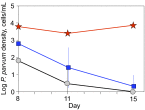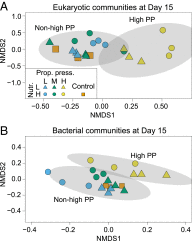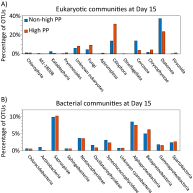Dynamics of an experimental microbial invasion
- PMID: 26324928
- PMCID: PMC4577205
- DOI: 10.1073/pnas.1505204112
Dynamics of an experimental microbial invasion
Abstract
The ecological dynamics underlying species invasions have been a major focus of research in macroorganisms for the last five decades. However, we still know little about the processes behind invasion by unicellular organisms. To expand our knowledge of microbial invasions, we studied the roles of propagule pressure, nutrient supply, and biotic resistance in the invasion success of a freshwater invasive alga, Prymnesium parvum, using microcosms containing natural freshwater microbial assemblages. Microcosms were subjected to a factorial design with two levels of nutrient-induced diversity and three levels of propagule pressure, and incubated for 7 d, during which P. parvum densities and microbial community composition were tracked. Successful invasion occurred in microcosms receiving high propagule pressure whereas nutrients or community diversity played no role in invasion success. Invaded communities experienced distinctive changes in composition compared with communities where the invasion was unsuccessful. Successfully invaded microbial communities had an increased abundance of fungi and ciliates, and decreased abundances of diatoms and cercozoans. Many of these changes mirrored the microbial community changes detected during a natural P. parvum bloom in the source system. This role of propagule pressure is particularly relevant for P. parvum in the reservoir-dominated southern United States because this species can form large, sustained blooms that can generate intense propagule pressures for downstream sites. Human impact and global climate change are currently causing widespread environmental changes in most southern US freshwater systems that may facilitate P. parvum establishment and, when coupled with strong propagule pressure, could put many more systems at risk for invasion.
Keywords: Prymnesium; diversity; invasion resistance; microbial ecology; propagule pressure.
Conflict of interest statement
The authors declare no conflict of interest.
Figures





References
-
- Litchman E. Invisible invaders: Non-pathogenic invasive microbes in aquatic and terrestrial ecosystems. Ecol Lett. 2010;13(12):1560–1572. - PubMed
-
- de Wit R, Bouvier T. ‘Everything is everywhere, but, the environment selects’; what did Baas Becking and Beijerinck really say? Environ Microbiol. 2006;8(4):755–758. - PubMed
-
- Fuhrman JA. Microbial community structure and its functional implications. Nature. 2009;459(7244):193–199. - PubMed
-
- Hanson CA, Fuhrman JA, Horner-Devine MC, Martiny JBH. Beyond biogeographic patterns: Processes shaping the microbial landscape. Nat Rev Microbiol. 2012;10(7):497–506. - PubMed
-
- Ruiz GM, Carlton JT, Grosholz ED, Hines AH. Global invasions of marine and estuarine habitats by non-indigenous species: Mechanisms, extent, and consequences. Integr Comp Biol. 1997;37:621–632.
Publication types
MeSH terms
Substances
Associated data
LinkOut - more resources
Full Text Sources
Other Literature Sources
Medical

